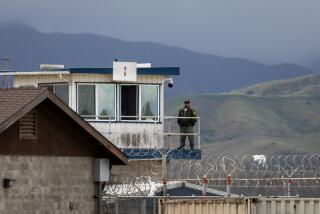California launches plan to cut prison population
- Share via
Reporting from Sacramento — State prison authorities Monday began reducing the number of parole violators sent back behind bars and offering inmates more opportunity to shorten their sentences, as part of a plan to decrease the prison population by 6,500 inmates over the next year.
Low-risk offenders, including those convicted of nonviolent crimes, will not have regular supervision by a parole agent. And they will no longer be returned to prison for technical violations such as alcohol use, missed drug tests or failure to notify the state of an address change.
Parole agents will reduce the number of inmates they supervise to focus on those the state deems to be at highest risk of committing more crimes, such as people who have committed sexual crimes and other violent offenses. Each agent’s caseload will fall from 70 parolees to 48.
In addition, prisoners can shave time off their sentences by working on firefighting crews or by obtaining a high school diploma or trade-school certificate or by completing drug or alcohol rehabilitation programs.
Over time, prisons chief Matthew Cate said, the rules will lower the rate at which parolees are returned to state lockups, reduce crime overall and “save, over the course of a full year, a half a billion dollars for California taxpayers.”
The state will thus address its prison overcrowding problem while “significantly increasing public safety,” said Cate, who heads the California Department of Corrections and Rehabilitation.
Some law-enforcement officials, state legislators and crime-victim advocates took a different view, predicting a spike in crime in California as more people leave prison earlier with less supervision.
LAPD Lt. Brian Johnson, a director of the Los Angeles Police Protective League, said the state “will start to release numerous dangerous felons into our community.”
Cate said that in a state prison system with 168,000 inmates, only 15% to 18% of inmates will be eligible for unsupervised parole, and that the effect of the changes will be gradual.
“No one gets out today,” he said.
The revisions were approved by the Legislature and signed into law last year by Gov. Arnold Schwarzenegger, who defended the changes Monday.
“It is not going to compromise public safety,” Schwarzenegger said in a Sacramento speech. “Every time you have inmates go out, they come right back in again -- 70% of them. That costs our state . . . a tremendous amount of money.”
The changes are occurring as the state has slashed budgets for education and rehabilitation programs in prisons.
“These people are not rehabilitated, and yet we’re going to open the door and let them out?” said Harriet Salerno, president of the group Crime Victims, speaking at a Capitol news conference that was also attended by representatives of Los Angeles police officers and Los Angeles County sheriffs’ deputies.
Sheriff Lee Baca said he is “very concerned” about the changes. He has ordered his deputies to meet with low-level offenders released from prison and tell them about community services such as mental health and drug rehabilitation programs, said Sheriff’s Lt. Wayne Bilowit.
Assemblyman Ted Lieu (D-Torrance), a former prosecutor running for state attorney general, introduced a bill Monday that would give local law enforcement officials a greater role in blocking the release of inmates they deem to be a risk to the public.
Times staff writer Shane Goldmacher contributed to this report.
More to Read
Sign up for Essential California
The most important California stories and recommendations in your inbox every morning.
You may occasionally receive promotional content from the Los Angeles Times.











